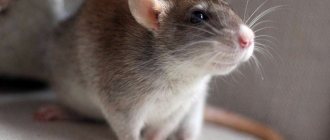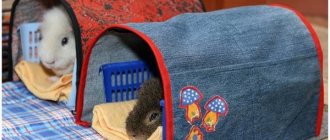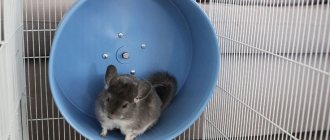In this century, people keep many different types of animals as pets. There was a time when dogs, cats and a few other animals were the only pet options people had. However, now you can meet the owners of rats and other exotic animals. Although rodents are small in size, they are very smart and cheerful.
Every owner of a pet rat wants to spend more time with it. To do this, you need to find a safe and reliable way for the animal to move freely in your company. Harnesses and leashes can help your pet travel with you or simply play freely.
What is a harness for?
Small animals are usually kept in cages. However, sometimes they will definitely want to get out of the cage and explore their surroundings better. If you have a rat as a pet, you should purchase a harness. She will allow the animal to roam outside the cage. With a harness and leash, you can easily let your pet roam around the room without worrying about losing a rat in a small space.
Rats are quite intelligent animals, and teaching them to perform some neat tricks is not a difficult task. Rat harnesses will also prevent your rat from escaping when you try to train it or even pet it. Once your rat is used to the harness and can walk normally on a leash, you can even try taking him out of the cage to explore your room on his own.
You can also walk your rat outside using a harness or leash, but many rodents will not respond well to a leash or going outside. If you do decide to walk your rat, make sure you have a tight-fitting harness and elastic leash, and be extremely careful when walking. Perhaps the best and less stressful way to take your rat with you is to use a rat carrier, which will keep your pet safe and give you peace of mind.
Results
A rat on a leash looks interesting and elegant. You need to accustom her to such walks first indoors, then in deserted places outdoors. Until you are completely sure that the rat feels good in a harness, you should not go for a walk with it in the park. Even in this case, you need to be careful so that other animals do not attack your pet, or that it does not fall under the wheels of a bicycle or car. It is necessary to ensure that all locks on the harness are securely fastened.
How to choose the right rat harness
Choosing a good rat harness is not an easy task. When making a choice, you must take into account certain factors and features. It is best to avoid collars. It will be very easy for a small pet to slip out of such a device. Even if you are able to purchase a quality collar that your pet cannot escape from, it can still pose a serious choking hazard. This is why you should always choose a harness that distributes pressure evenly across your entire chest.
It is also important to make sure that the harness you choose fits your pet comfortably. It should be loose enough to allow the rat to move freely, but tight enough to prevent the animal from escaping. Obviously, you won't find a harness specifically designed for rats. There's nothing to worry about here. Just look for those harnesses that fall into the small animal category.
Chew toys
When pet rats get bored, they start chewing on something. To prevent them from chewing on your furniture, blankets and carpets, make your own chew toys for them.
- Walnuts in shell. The hard shell will not allow you to quickly eat the nuts and will occupy the teeth of rodents.
- Boiled chicken or beef bones.
- Wooden chew toys (not pine ones). You can buy such toys at a pet store, or you can cut disposable wooden sticks yourself. A popsicle stick works well, or you can even leave a little of the treat on it. Your tailed friends will thank you for this.
- Dog biscuits are hard, low in protein and fat.
- Baby crackers for teething.
- Wine corks.
- Cardboard boxes are a convenient house and a chewing toy in one.
Rat teeth are constantly growing, so they simply need to constantly chew on something to wear them down. To prevent your pets from chewing everything, offer them chewing toys.
Main varieties
There are 3 main types of harnesses. However, you can buy a collar, but it can put pressure on the rat’s neck. Therefore, you should choose from the following types of accessories:
- Figure 8 Harness - This type of harness has two loops, one going behind the front legs and the other going around the neck. The device is attached at the junction of two loops at the withers (the base of the neck above the shoulders).
- H-shaped harness – This accessory has two loops, like a figure eight. But the loops are not connected directly; they are connected by a separate piece of material, such as a nylon strap.
- A harness vest is a fitted fabric vest that fastens around the neck and belly with Velcro, buttons or zippers and has a ring at the back for attaching a leash.
If you don't want to buy a harness, you can make your own.
Popular models
Let's look at hamster leashes and harnesses that are popular with pet owners. The following models have proven themselves well:
- Gamma. A simple harness made of cord with a diameter of 6 mm, leash length 1.3 m. For large hamsters. Metal carabiner and sliders. Price – from 100 rubles.
- Ferplast. Open harness made of nylon cord. The size is easily adjustable, so the accessory is suitable for dwarf hamsters and large Syrians. Cost – from 220 rubles.
- Ferplast jogging small. A vest for small rabbits, which is also suitable for a well-fed hamster. The size is adjustable, all fastenings are made of plastic. Costs 690 rubles.
- Taonmeisu. Open harness for jungarik with a bell. The harness itself is made of nylon, the fastenings are metal. Price from 170 rubles.
Not everyone has the opportunity to purchase such things for their tiny pet. If you want to dress up or walk your pet, you will have to make an accessory for your hamster with your own hands.
Necessary materials
The simplest variety to make yourself is a figure eight shaped harness. In order to make it, you only need one rope. It should be long enough, so it should be used for the area around the neck and body. Therefore, its length should be at least 20cm. Any material will do. However, it is important to avoid rough abrasive ropes, which can irritate your rat's skin.
To create an H-shaped harness, you will need three nylon collars for small pets. You can buy adjustable collars for less than RUB 150 each. You will need three different sizes:
- A collar that fits the rat's neck.
- One that will hug her chest just behind her front paws.
- A long collar that will be used as a connecting element.
To create a vest harness you will need high-quality elastic fabric and a metal ring. You can use special fabric for animals, but regular fleece or cotton fabric will do just fine.
The process of creating a harness
To create a figure eight harness, follow these instructions:
- Fold the rope so that you have two unequal lengths: one about 15 cm and the other 2 cm.
- Wrap the center of the rope under the rat's neck.
- Cross the two sides of the rope behind the rat's back between its shoulders and pass the shorter part of the rope around the pet's chest just behind the paws and back up to meet the other side of the rope.
- Tie a knot where the two ropes intersect. This will allow you to adjust the harness when taking it on and off.
To make an H-shaped harness, repeat these steps:
- Remove the clasp from the long collar. Be sure to leave the leash ring intact so you have room to attach the harness.
- Measure the appropriate length of the connecting piece. Wrap the collars around the rat's neck and chest. Place the third collar along her back between her shoulder blades, with the leash ring in the middle, and mark the points where the third collar overlaps the far side of the other two collars.
- Sew loops on the ends of the connecting piece. Fold each end of the joining pieces just beyond the mark you made. Sew the folded ends together to form loops on each end.
- Thread the collar around your neck and chest through the loops to create an H-shaped harness. Once you pass the collars through the loops on the connector, your H-shaped harness is ready to use.
To create a harness vest, you will again need to measure the rat's neck, chest behind the legs and a few more centimeters on its torso. Then you can use stretch fabric.
- Cut the fabric to the desired size. You will need to leave some extra fabric for joining. If the vest is to be attached with Velcro or buttons, the two sides will need to completely overlap.
- Wrap the cut fabric around the rat and mark where its paws are.
- Cut out holes for the paws.
- Reinforce all edges of the fabric, including the paw holes, by folding the fabric and sewing it underneath.
- Attach Velcro, snaps, buttons or zippers.
- Sew a ring to the top of the vest between the rat's shoulders.
Ratmaniya
Why do you need a walk?
Wild rats live in protected burrows or other types of shelters and search for food in nearby habitat. This dual structure of the living space largely determines the instincts of decorative rats and influences their behavior. Therefore, the need of rats for a daily walk is, on the one hand, a behavioral factor inherited from decorative rats from their wild ancestors, on the other hand, a physical need for movement, which is completely impossible in cage conditions, and a psychological need for new impressions and emotions. While a cage is a protected refuge for rats, a walk brings the necessary variety to a rat's life - it is their permanent habitat in which they can explore new things, frolic, play and fully communicate with their owner.
Memo for beginners
What you need to consider when organizing a rat walk:
- Rats should walk every day for at least 2 hours, it is better if it is several hours;
- Protect rats from possible dangers as much as possible;
- Access to food and water must be maintained during walking;
- If rats are walking on the sofa, do not forget to throw a blanket over it, this will protect the upholstered furniture from gnawing and rat marks;
- All things need to be regularly updated and swapped;
- Don't forget that the best toy for a pet rat is a human, so don't forget to be present on the walk, communicate with them and take part in rat games.
- Rats are not allowed to walk in a walking ball or on a harness .
What should the walking area be like?
To make a walking area attractive and useful for rats, you need to organize it accordingly. The following things and items are suitable for this:
- A special walking blanket or blanket to protect furniture;
- Accessories for climbing (thick branches, small play structures for cats, etc.);
- Hiding places and resting places (boxes with cut-out entrances, pipes, etc.);
- Educational toys (homemade or purchased toys for dogs and cats);
- A carelessly thrown sheet or any fabric (this is an almost ideal accessory for playing hide and seek);
- Homemade walking complexes (you can read more about them here).
How to put a harness on a rat
When you are trying to put a rat harness on your pet, the most important factor to keep in mind is your pet's comfort level. It is important that the animal feels calm when wearing the harness. If your rat shows any signs of anxiety while you are trying to put the accessory on it, stop what you are doing immediately. You can try to give your pet some positive associations with the harness, such as offering him treats when he sniffs the harness or when you try to put it on.
Once you are able to put the harness on, let your pet get used to it without fastening it or tightening it. The rat will need to spend some time with the harness to get used to the sensation the accessory has on its neck and shoulders. If you notice signs of anxiety in your rat, remove the harness and offer it a treat. Try again after a while.











